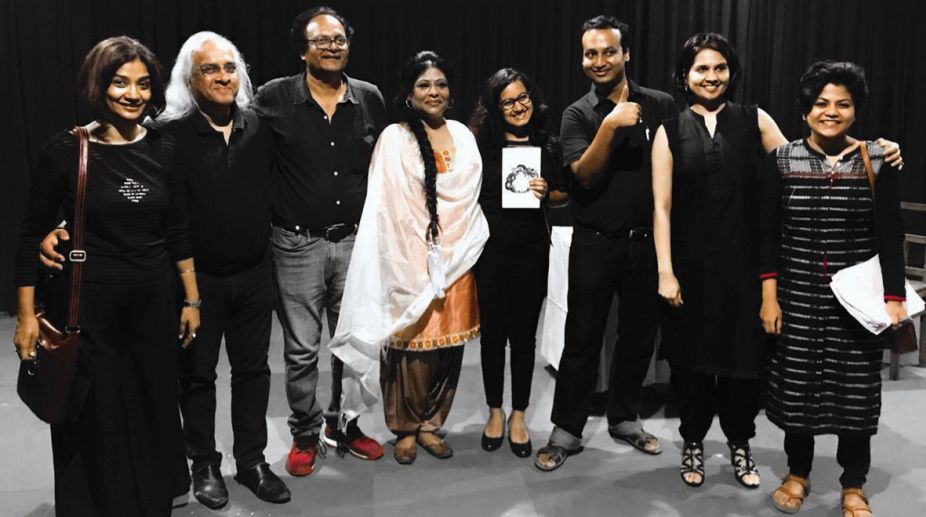Allu Arjun, Jackie Shroff call for a green, plastics-free planet on Earth Day
Telugu superstar Allu Arjun and Bollywood actor Jackie Shroff observed the Earth Day on Monday.
Rangkriti’s Khanabadosh brings alive the eccentric autobiography of an unconventional woman writer who broke every rule in the patriarchal book.

The most amazing quality of a successful one-actor or monologue performance is the gift of memorising an entire play by the performer who uses the whole time and space to perform the play all alone. This does not comprise of memorising the lines alone.
It extends to everything associated with the concept and physical reality of acting per se such as body language, silence, facial expressions, flow of dialogue and vocal pitch rising and falling with the emotional swings in the character to invest the performance with the authenticity that the character being portrayed is consistent with.
Rangkriti’s Khanabadosh is based on the well-known autobiography in the form of collected writings by noted Punjabi litterateur Ajit Cour who was bestowed the Sahitya Academy Award in 1985 for this autobiography. She was also given the Padma Shri in 2006.
Advertisement
The actor and director chose two pieces called Ghoga aur Samandar and Saat Neem -Kash Teer from Khanabadosh that contains slices of the writer’s life that are interwoven into the emotional ups and downs of her life and her love similar to the rising and falling waves of the sea.
In fact, the sounds of waves form an eloquent segment of the moving background score not only because of the infinity the sea suggests but also because it is in perfect rhythm with the emotional turmoil the subject passes through time and again.
For those not familiar with the world of Punjabi women writers, Cour’s is a renowned presence with noted contributions to Punjabi literature, mainly fiction. She has written novels and short stories in Punjabi language on social-realist themes such as the experience of women in relationships and their position in society. Her 20 books of short stories speak for her as do her edited works and novelettes, an art of writing she has pioneered.
The word khanabadosh means “vagabond” which is an intriguing title for an autobiography of a woman considering that the adjective “vagabond” is generally applied to the male of the species. How can a woman be a vagabond who, patriarchy for thousands of years has defined as contained within the four walls of a home forever? The play suggests and sometimes, even provides the answers while raising some questions too.
Nivedita Bhattacharjee under the directorial wand of Jeetendra Singh brings alive the unconventional autobiography of an unconventional woman writer who broke every rule in the patriarchal book to live life on her own terms and also, to illustrate how a woman’s love for a man who is not her husband can lead to the same betrayal she has been subjected to within a married relationship.
This is so subtle and understated that the woman concerned does not even realise that she has been emotionally blackmailed and duped to believe in a love that forever, was one-sided on the part of the woman while she surrendered to his physical demands and also enjoyed the surrender knowing well that he was married with children.
Bhattacharjee takes the not very big space of Padatik Little Theatre as her platform to stride across it, sit on the two small cane modas positioned on the sides of the performance space, with a symbolic table and chair with books and notebooks piled on top to suggest the life of a writer. Cour in real life is a very small-boned, petite woman who hardly raises her voice unless she feels it necessary.
Her delicate features and demeanour are deceptive that do not hold forth her girt and her determination never to bow down to inner and outer pressures — social, emotional and physical, come what may. She is also a successful mother having brought up one of the most talented among contemporary Indian artists like Arpana Cour.
Though Bhattacharjee’s personality, height and image are distanced from the subject she was portraying, without trying any pretentious attempts to compromise on this distance, invests the character with the bold strokes it demands, as she narrates the life story of her subject, focussing mainly on her relationship with a married man she calls Omi.
Her body language narrates its own story of courage, grit and determination as she juggles her life between and among bringing up her two kids as a single parent, her job, her time in writing and her love life in the company of Omi and some other intellectual friends.
The direct interactions in a red light area are a bit too difficult to digest but it goes with the performance. The muted music, used strategically and minimally to suit mood swings is truly good. Her costume, slightly decorative but not loud, filled with feminine grace in shades of light pink, matches the persona and the situations.
Questions that plague a solo acting performance rise from the constant vacillating between subjectivity and performance that essentially means whether the performer overshadows the subject she is performing or whether her performance is an ideal blend between the subject and the performer performing the subject.
In the case of Khanabardosh, director Singh and performer Bhattacharya triumph with the latter where the subjectivity is not overshadowed by the performer mainly because not everyone in the audience is familiar with the personality of the subject — Ajit Cour.
Nevertheless, in terms of uniqueness and excellence, one must grant it to the actress and the director for having given us an outstanding testimony to what a mono performance stands for.
Advertisement